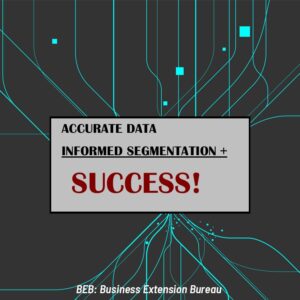 In 2025, prominent marketing trends will center around harnessing AI for enhanced personalization and operational efficiency, embracing social commerce, and focusing on user-generated content. Consumers will increasingly seek interactive and immersive experiences while maintaining a steady concern for sustainability and ethical marketing practices.
In 2025, prominent marketing trends will center around harnessing AI for enhanced personalization and operational efficiency, embracing social commerce, and focusing on user-generated content. Consumers will increasingly seek interactive and immersive experiences while maintaining a steady concern for sustainability and ethical marketing practices.
Over the next few weeks we will look closer at AI-Driven Marketing, Social Commerce, User Generated Content and other noteworthy trends.
Category Archives: Blog With BEB
Accurate Data and Informed Segmentation
 In the competitive landscape of marketing, ensuring the accuracy of customer addresses is critical to reducing undeliverable mail and minimizing wasted spending. By implementing verification tools, companies can maintain an up-to-date database that prevents costly errors and enhances the efficiency of their direct mail campaigns. Address accuracy not only improves delivery rates but also fosters trust and credibility with consumers, who are more likely to engage with communication that reaches them timely and effectively. As marketers increasingly recognize the financial implications of undeliverable mail, investing in reliable verification solutions becomes a smart strategy for optimizing marketing efforts.
In the competitive landscape of marketing, ensuring the accuracy of customer addresses is critical to reducing undeliverable mail and minimizing wasted spending. By implementing verification tools, companies can maintain an up-to-date database that prevents costly errors and enhances the efficiency of their direct mail campaigns. Address accuracy not only improves delivery rates but also fosters trust and credibility with consumers, who are more likely to engage with communication that reaches them timely and effectively. As marketers increasingly recognize the financial implications of undeliverable mail, investing in reliable verification solutions becomes a smart strategy for optimizing marketing efforts.
Moreover, segmentation plays a vital role in driving engagement and conversions. By adjusting messaging based on client history, service needs, and browsing behavior, companies can create targeted communications that resonate deeply with individual customers. This personalized approach not only enhances the customer experience but also improves campaign performance, as audiences are more likely to respond to messages that acknowledge their unique situations and preferences.
To maximize the impact of marketing endeavors, companies must also pay attention to customer actions as indicators for outreach efforts. Sending mail when a customer browses your website demonstrates a genuine interest in their journey and reinforces the brand’s commitment to meeting their needs. However, challenges such as duplicates, limited behavioral data, and outdated information can hinder effectiveness. The best-performing teams in the industry are proactively addressing these issues with enhanced data hygiene practices and real-time insights, ensuring that they can harness smarter targeting strategies to elevate their marketing campaigns and drive better results. By prioritizing accurate data and informed segmentation, marketers can overcome challenges and cultivate deeper connections with their customers.
Auto Marketers ID Direct Mail As Top-Performing Channel
 Automotive marketers are increasingly recognizing the enduring effectiveness of direct mail, with a remarkable 83% identifying it as their top-performing channel.* This remarkable statistic underscores the channel’s pivotal role in driving customer acquisition, retention, and service marketing within the automotive sector. By utilizing direct mail, automotive businesses can deliver tailored messages directly to their target audiences, making their marketing efforts not only more effective but also more personal. The ability to craft compelling, targeted communications enables brands to connect with potential customers at critical moments in their buying journey, fostering engagement and encouraging brand loyalty.
Automotive marketers are increasingly recognizing the enduring effectiveness of direct mail, with a remarkable 83% identifying it as their top-performing channel.* This remarkable statistic underscores the channel’s pivotal role in driving customer acquisition, retention, and service marketing within the automotive sector. By utilizing direct mail, automotive businesses can deliver tailored messages directly to their target audiences, making their marketing efforts not only more effective but also more personal. The ability to craft compelling, targeted communications enables brands to connect with potential customers at critical moments in their buying journey, fostering engagement and encouraging brand loyalty.
Moreover, these marketers are at the forefront of leveraging automation to enhance the impact of their direct mail campaigns. By implementing smarter targeting techniques and integrating digital tools, automotive operators can ensure that every piece of mail works harder to drive results. This seamless integration of automation with direct mail not only streamlines marketing processes but also enhances the overall customer experience. As automotive companies continue to embrace these strategies, they will likely find success in creating more meaningful interactions with customers, ultimately leading to improved retention rates and stronger brand connections. As the industry evolves, the combination of direct mail and cutting-edge automation suggests a promising future for automotive marketing.
Nearly 80% of Auto Marketing Use Direct Mail
 Direct mail is experiencing a significant resurgence, with surveyed respondents across various industries planning to double their direct mail volume by 2025. This increase reflects a growing recognition of the effectiveness of direct mail as a marketing tool and its ability to complement digital efforts. In the competitive landscape of automotive marketing, direct mail campaigns can create a tangible connection with potential customers, delivering targeted messages that resonate on a personal level. As marketers increasingly adopt data-driven strategies, the emphasis on direct mail will likely strengthen, capitalizing on its ability to stand out in a cluttered digital environment.
Direct mail is experiencing a significant resurgence, with surveyed respondents across various industries planning to double their direct mail volume by 2025. This increase reflects a growing recognition of the effectiveness of direct mail as a marketing tool and its ability to complement digital efforts. In the competitive landscape of automotive marketing, direct mail campaigns can create a tangible connection with potential customers, delivering targeted messages that resonate on a personal level. As marketers increasingly adopt data-driven strategies, the emphasis on direct mail will likely strengthen, capitalizing on its ability to stand out in a cluttered digital environment.
Furthermore, automation is playing a critical role in enhancing the effectiveness of direct mail campaigns. Nearly 80% of automotive and e-commerce companies are collaborating with automation platforms to improve their marketing efforts. This partnership enables businesses to streamline processes, enhance targeting, and optimize campaign performance. However, it’s essential to address the challenge of outdated data, as 44% of marketers report that inaccurate customer records are hindering their efforts and leading to missed opportunities. By prioritizing data accuracy and embracing automation, marketers can fully harness the power of direct mail, ensuring that their strategies are both effective and efficient as they navigate an increasingly complex marketing landscape.
A Look Into The Automotive Future
 We just finished reading a report entitled, Automotive Outlook 2040, published by Roland Berger. Roland Berger is a prominent global strategy consultancy, recognized for its extensive service offerings that cater to a variety of industries and business functions. With a rich history since its founding in 1967 and headquartered in Munich, the firm has established itself as a leader in transformation, innovation, and performance improvement, all while prioritizing sustainability across its projects.
We just finished reading a report entitled, Automotive Outlook 2040, published by Roland Berger. Roland Berger is a prominent global strategy consultancy, recognized for its extensive service offerings that cater to a variety of industries and business functions. With a rich history since its founding in 1967 and headquartered in Munich, the firm has established itself as a leader in transformation, innovation, and performance improvement, all while prioritizing sustainability across its projects.
Our take is the automotive industry is undergoing a profound transformation, reshaping the landscape in ways that may not align with conventional expectations. One of the most significant shifts is the move from globalization to regionalization, highlighting an increasingly polarized market. As manufacturers adapt to local preferences and demands, we are seeing a growing emphasis on local-for-local products that resonate more deeply with consumers in specific regions. Additionally, the emergence of artificial intelligence is fundamentally altering production processes, moving the industry from human-driven operations to automated systems that optimize efficiency and precision. Meanwhile, the focus has shifted from raw horsepower to vast amounts of data—terabytes—needed to support advanced connected vehicle technologies and enhance user experiences.
As this evolution unfolds, the dynamics between markets are becoming increasingly nuanced. While Chinese automakers and companies in the Global South are rising swiftly in prominence, Western markets continue to hold their ground, leading to complex competition and collaboration. Original Equipment Manufacturers (OEMs) face a pivotal juncture: will they navigate the dominance of Chinese manufacturers, or will a revitalization of Western innovation redefine the market? Suppliers also find themselves at a crossroads, discovering new revenue opportunities while managing a shifting balance of power that demands agility and adaptability. As the automotive world presses forward into uncharted territory, it is clear that the journey ahead is not just a sprint but a marathon, requiring strategic foresight and resilience to thrive in this rapidly evolving climate.
OTTER AI
 10 AI Programs in use today.
10 AI Programs in use today.
#10) OTTER AI
Otter.ai helps to manage meetings using an AI-powered assistant that records, transcribes, and summarizes discussions in real-time. By offering automatic note-taking, speaker identification, and action item tracking, Otter empowers users to focus on what truly matters during meetings. With seamless integration into popular platforms such as Zoom, Google Meet, and Microsoft Teams, Otter is designed to make the meeting experience more efficient and productive.
One of the standout features of Otter.ai is its real-time transcription capability, allowing users to generate searchable meeting transcripts instantly. In addition to capturing the conversation, Otter automatically summarizes key points and action items, eliminating the need for manual note-taking. The platform also identifies and tags different speakers in the transcript, making it easy to follow conversations and ensuring that everyone’s contributions are recognized. It also offers, OtterPilot, an AI-powered bot that can join meetings on a person’s behalf.
Otter.ai is beneficial across multiple use cases, from business meetings and educational settings to interviews and personal conversations. The ability to export transcripts in various formats and easily share them with others enhances collaboration among team members. With a free plan that offers 300 minutes of transcription each month and paid options for those needing more extensive features, Otter.ai caters to a wide range of users looking to streamline their meeting management and improve productivity.
USPS RATE INCREASE EFFECTIVE JULY 13, 2025

The U.S. Postal Service (USPS) has approved the rate case set to increase various mailing services effective July 13, 2025. These changes include a 5-cent increase in the price of a First-Class Mail Forever stamp from 73 cents to 78 cents, and an overall increase in mailing service prices of approximately 7.4%.
CLICK HERE FOR A SIMPLIFIED-PRINTABLE RATE CHART
CLICK HERE FOR A DETAILED-PRINTABLE RATE CHART
Hurricane Season is Here! Be Prepared.
In Texas, hurricane season spans from June 1 to November 30. The likelihood of experiencing storms, including hurricanes and tropical storms, peaks from August to October, coinciding with the warmest sea surface temperatures in the Gulf.
According to NOAA, the forecast includes 13 to 19 named storms, with 6 to 10 expected to develop into hurricanes, and 3 to 5 of those potentially becoming major hurricanes. It’s essential to start your preparations now.
At the very least, assemble the following basic supplies into an easily transportable emergency preparedness kit that you can use at home or take with you if evacuation becomes necessary.
Basic Emergency Kit
WATER – one gallon per person, 3-day supply for evacuation, 2-week supply for home
FOOD – non-perishable food, 3-day supply for evacuation, 2-week supply for home
CELL PHONE CHARGER – car charger or one that can work when the power goes out (solar, crank, battery pack)
FLASHLIGHT – for each person, plus extra batteries
FIRST AID KIT – deluxe family kit
PRESCRIPTIONS- medications for two weeks and backup glasses
KITCHEN ACCESSORIES- plates, utensils, & manual can opener
TOILET PAPER – enough for all, plus other hygiene items
CASH – small bills
ICE CHEST – no refrigerator for weeks is possible
GAS CAN – safely store gasoline for cars and generators
CLOTHING – complete change of clothes, including sturdy shoes and hat
SLEEPING BAGS – bedding that can be portable
TOYS AND GAMES – entertainment for kids & adults
MULTI-PURPOSE TOOL – compact device with knife, screwdrivers, and pliers
Be prepared and stay safe this hurricane season!
Click here to download a printable check list
HubSpot
 10 AI Programs in use today.
10 AI Programs in use today.
#9) HubSpot
HubSpot AI is a suite of tools designed to enhance marketing, sales, and customer service operations. This integrated platform leverages artificial intelligence to simplify tasks, offering features such as content creation, website development, and in-depth data analysis.
One of the features of HubSpot AI is its content generation capabilities. The AI Content Assistant aids users in crafting various types of content, from blog posts to social media updates, while the AI-powered blog post generator can create drafts based on simple prompts. Furthermore, the AI-assisted copywriting tool helps refine marketing materials to ensure they resonate with target audiences. Coupled with an intuitive AI website builder that can launch websites based on user inputs, HubSpot AI maximizes efficiency and creativity in content-driven strategies.
Beyond content and websites, HubSpot AI enhances data analysis and customer interaction through features like Smart CRM and predictive AI, offering actionable insights that inform business decisions. Automation tools streamline workflows and minimize repetitive tasks, allowing teams to focus on strategic growth. With a commitment to ethical AI practices, HubSpot not only helps businesses improve productivity and customer experiences but also fosters growth in a responsible, impactful manner.
MIDJOURNEY
MidJourney is an AI-powered tool that specializes in generating high-quality images based on textual descriptions, allowing users to create stunning visual art with ease. Utilizing advanced machine learning algorithms, MidJourney transforms user-inputted prompts into intricate and imaginative images, catering to a diverse range of creative needs—from graphic design and marketing materials to concept art and personal projects. Accessible through platforms like Discord, it enables artists, designers, and hobbyists to experiment with various styles and themes while receiving instant visual feedback. By bridging the gap between imagination and creation, MidJourney empowers users to explore their creativity and produce unique artwork, even if they lack traditional artistic skills.


